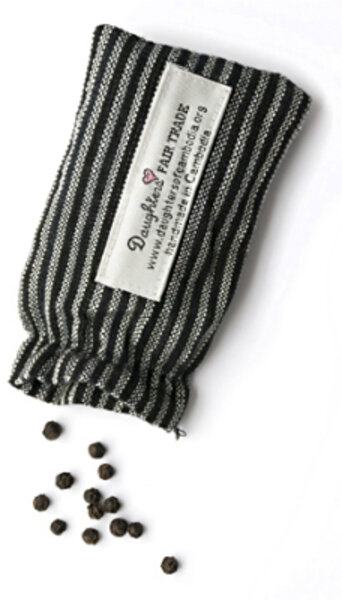Black pepper beef with Kampot pepper from the Pepper Project
Loading...
One simple ingredient can often make all the difference when you’re cooking. And now that’s more true than ever. The ingredient in this case is black pepper – freshly ground, of course, instead of pre-ground and packed in a tin. Freshly ground peppercorns pop with flavor and fragrance, becoming a true flavor, not just background noise, and you can control the grind, from fine to coarsely cracked.
And in Cambodia, the Pepper Project is making a difference, with pepper. Run by the husband and wife team Tom Gordon and Cris Peterson, the Pepper Project is a not-for-profit enterprise devoted to introducing products of Cambodia to the United States. Through the sales of these products, primarily pepper, they support fair trade for farmers as well as organizations that protect street children, disabled children and victims of sex trafficking.
The Pepper Project imports organic peppercorns from areas in Cambodia that are approved with the United Nations Geographic Indicator designation. They purchase only from farmers who pay fair labor wages, and and donate 100 percent of their profits to Cambodian charities and projects. You can find out more about the Pepper Project and the work it does – and purchase Kampot pepper – at its website (www.pepperproject.org).
Pepper from the Kampot region of southwestern Cambodia has long been prized for its delicate, bright, fruity aroma and flavor by European chefs and restaurateurs. Pepper Project’s goal is to make it readily available throughout the United States. It’s already getting some attention. Anthony Bourdain says, “It’s got a floral dimension that’s really something special.” And at Le Bernardin in New York, executive pastry chef Michael Laiskonis has used it to flavor everything from ice cream to goat-cheese mousse. It also packs a subtle bit of heat that sneaks up on you.
The sample we received from the Pepper Project showed us what all the fuss was about. We’ve long been proponents of freshly ground pepper, but this was something more. I ground some of our go-to peppercorns into one ramekin and Kampot peppercorns into another. The fragrance alone told the story – the Kampot peppercorns were markedly more fragrant, brighter, bolder. We couldn’t wait to cook with them.
My first choice to test-drive Kampot pepper would have been Spaghetti with Pecorino Romano and Pepper, a four-ingredient dish in which pepper is the star. Unfortunately, I’d already written about it here. My next thought was black pepper beef, a classic Chinese stir fry. It’s a weeknight quick Cantonese dish from the Guangdong province. Besides beef and black pepper, it features bell pepper, ginger, onion, garlic and, in my version, celery. The marinade/sauce includes soy sauce, oyster sauce, and sesame oil.
Black pepper beef
Serves 2 as a main course or 4 as part of a multi-course meal
8 ounces flank steak
1-1/2 tablespoons soy sauce
1-1/2 tablespoons oyster sauce (available in Asian markets and some supermarkets)
1-1/2 tablespoons Chinese wine or dry sherry (optional, may substitute cooking wine)
1 teaspoon sesame oil
1/2 teaspoon sugar
1 teaspoon corn starch
1-1/2 teaspoons freshly ground black pepper, divided
2 tablespoons (or more) canola oil
1/2 large onion, sliced into thin half moons
1 medium red bell pepper, cut into bite-sized chinks
1 inch fresh ginger, peeled and sliced thin
1 celery rib, sliced
1 clove garlic, minced
Cooked white rice
Extra soy sauce, for passing at the table
1. Slice the flank steak across the grain into 1/3-inch thick slices. Cut the slices into bite-sized pieces. Mix soy sauce, oyster sauce, Chinese wine (if using), sesame oil, sugar, corn starch and 1 teaspoon of pepper in a large bowl. Add beef and toss to coat. Set aside and marinate for at least 15 minutes. Using a slotted spoon, transfer beef to another bowl, reserving excess marinade.
2. Heat canola oil in a wok or large nonstick skillet over medium-high flame. Add beef to skillet and stir fry for about 2 minutes, tossing frequently. Transfer back to bowl with slotted spoon.
3. Add onion, bell pepper, ginger, celery and garlic to pan. Cook, stirring constantly, for about 1-1/2 minutes. Return beef to pan along with reserved marinade and cook about 1 minute longer. Transfer to serving dish and top with remaining ground pepper. Serve with rice. Pass soy sauce at table. Also, be sure to tell diners to avoid the ginger slices. Seriously.







